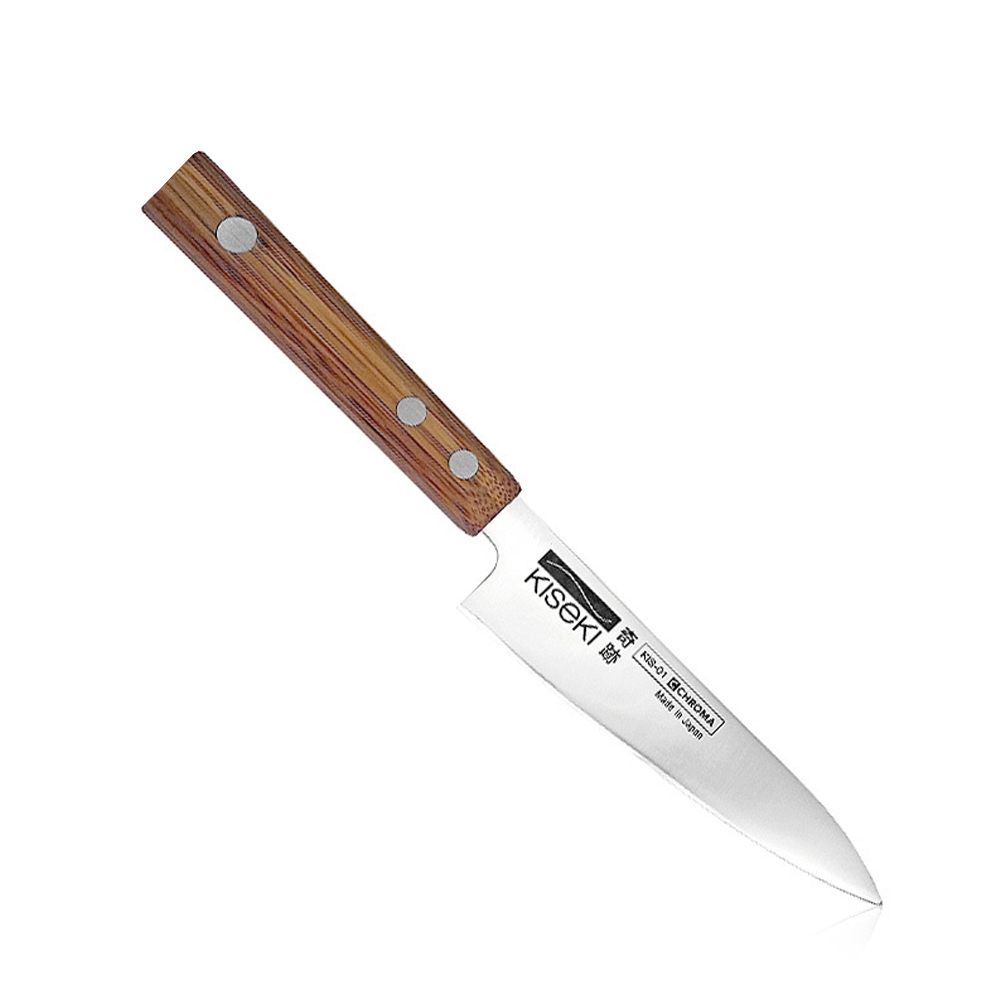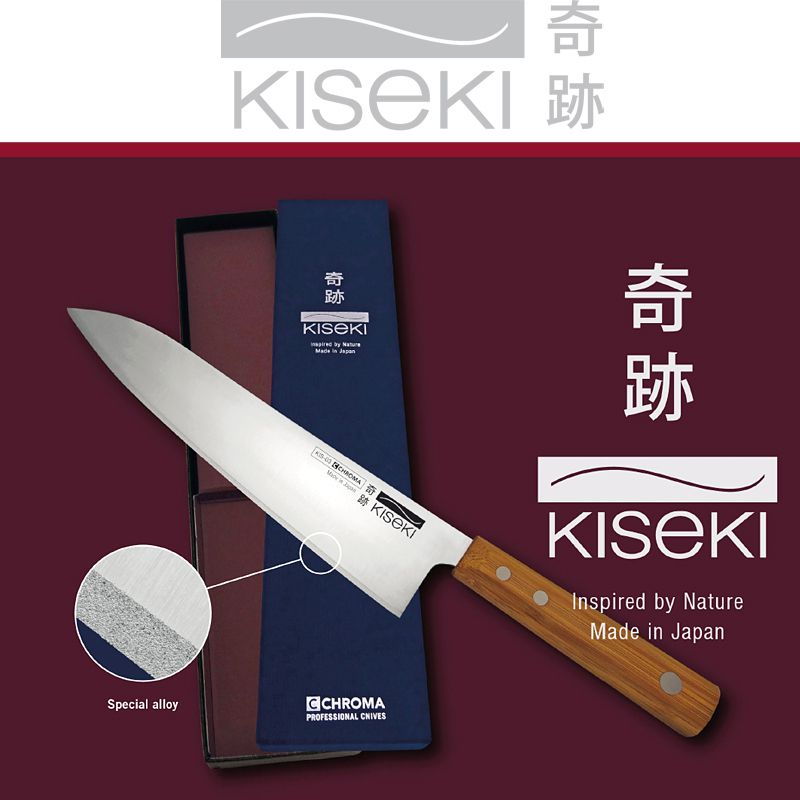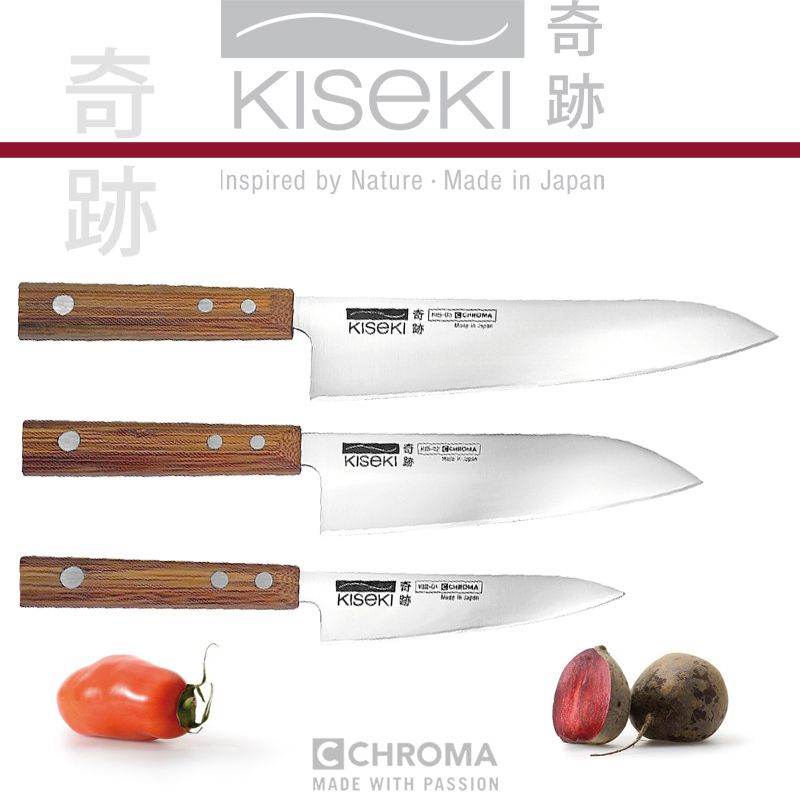CHROMA KISEKI - Petty 11 cm - Indispensable for peeling, chopping and decorating. Small and handy utility knife
- blade length: 11 cm / 4,3"
- Blade: high-quality, stainless molybdenum-vanadium steel
- +/-1 59° HRC
- Cut: both sides cut
- Handle: bamboo laminate
- Made in Japan
Since ever knife manufacturers have been searching for the perfect knife: one which is very sharp and stays sharp forever, easy to maintain and easy and comfortable to hold. The Japanese KISEKI cnife by CHROMA comes very close to this ideal.
奇跡 KISEKI is Japanese and means miracle! Vou will understand once you have worked with your KISEKI!
CHROMA‘S new, three piece knife range "KISEKI" was developed by experienced Japanese engineers.
The scientists copied nature. This is called “bionics" or “biomimicry". The incisors of rodents are made of two different
materials: The largest part of the tooth consists of a relatively soft dentin. It is similar soft as aluminum. In contrast, the tooth front page covered a thin layer of extremely hard enamel. Enamel is the hardest material in the animal kingdom; You can even engrave aluminum with it. It is as hard as construction steel. While using the teeth, the soft dentin wears out faster than the hard enamel. As a result, at the junction of these two layers. a razor»sharp edge of hard enamel always occurs. This condition is copied by the engineers. They "amalgamated" the KISEKI metal alloy - that is clearly visible on the leit side of the cnife edge, and that is much harder than the already hard enamel.
This veny expensive special alloy was originally invented for space travel and protects among other materials the jet engines of spaceships against corrosion in cosmos.
The base blade, a high-quality, stainless molybdenum-vanadium steel is harder than dentin and hardened at 59° Rockwell C. So the cnife stays sharp longer, a lot longer than rodent teeth if those would not grow new.
Rodents enamel and dentin grow. Renewable metals do not exist (yet). Therefore, after some time - due to use - mostly
after years - also KISEKI cnives become dull. However it can be extremely sharp regrinded by CHROMA whetstone.
The developers took a different approach for the the KISEKI cnife handles. They interviewed many good chefs in Japan and observed how they work with their knifes. They also interviewed amateur cooks. They found out fairly quickly there was a great interest in a wooden handle, which lays firmly in the hand and - different from the traditional Honoki handles in Japan - the consumer no longer wants a handle that needs to be replaced from time to time.
The researchers took over the Western concept of rivets that hoid the handle and modified the handle in a traditional Japanese way. The outcome was the "Hachikakukei no" handle, an octagonal form, which is particularly safe and extremely comfortable to hold in the hand. Now, the question for the best wood. At a conference the engineers met colleagues from Lexus, the luxury car manufacturer. They raved about a new type of bamboo laminate, which feels great and is extremely durable. Lexus has their own bamboo forest. Since the Lexus people welcomed the idea of a knife handle from their material, they now Supply this high quality material, so the handle can be perfected.
Bamboo is a renewable resource with good sustainability.
KISEKI is probably not the perfect knife and will not be - as long as there is no self-renewable metal. However, KISEKI comes very close to a perfect knife. Atso, because you can sharpen it quick and easy yourself and it is so sharp from the beginning.
Login




